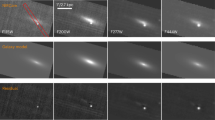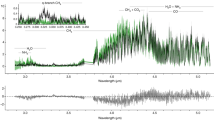Abstract
IN a recent article1, Ohio State University maps covering 300 square degrees of the sky surrounding the Andromeda Nebula (M31) were presented for two frequencies, 600 and 1,415 Mc/s. The radio isophotes close to M31 on the higher resolution (1,415 Mc/s) map are of particular interest and are shown in more detail in Fig. 1 as superimposed on a photograph taken for me by C. A. Feuchter. The area covered in Fig. 1 is about 14 square degrees (3.5° × 4°). The size of the antenna beam at half-power is 11′ × 35′ so that there are about 160 beam areas in the map. The isophote interval is in units of 0.05° K of antenna temperature.
This is a preview of subscription content, access via your institution
Access options
Subscribe to this journal
Receive 51 print issues and online access
$199.00 per year
only $3.90 per issue
Buy this article
- Purchase on Springer Link
- Instant access to full article PDF
Prices may be subject to local taxes which are calculated during checkout
Similar content being viewed by others
References
Kraus, J. D., Nature, 202, 269 (1964).
Baldwin, J. E., and Costain, C. H., Mon. Not. Roy. Astro. Soc., 121, 413 (1960).
Large, M. I., Mathewson, D. S., and Haslam, C. G. T., Nature, 183, 1250 (1959).
Lyngå, G., Commun. (Meddelande) Lund Astro. Observatory. Ser. II, No. 137 (1959).
Author information
Authors and Affiliations
Rights and permissions
About this article
Cite this article
KRAUS, J. Does the Andromeda Nebula (M31) have a Halo?. Nature 202, 1202–1203 (1964). https://doi.org/10.1038/2021202a0
Issue Date:
DOI: https://doi.org/10.1038/2021202a0
Comments
By submitting a comment you agree to abide by our Terms and Community Guidelines. If you find something abusive or that does not comply with our terms or guidelines please flag it as inappropriate.



